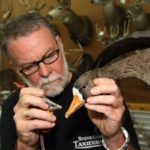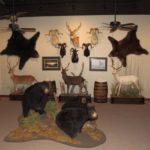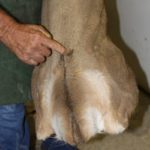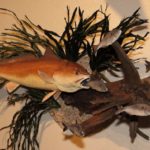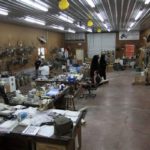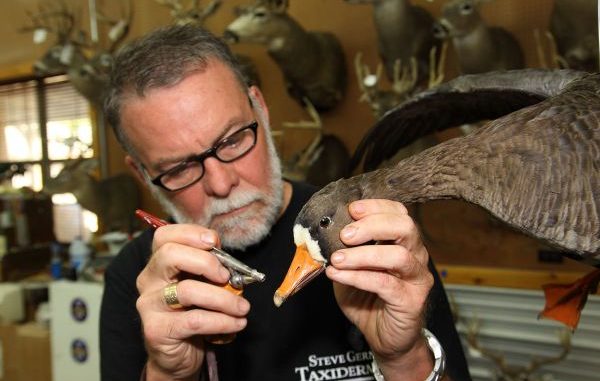
Proper preparation by hunter allows taxidermist to produce a work of art.
The crashing noise startled me.
It was like a sound effect from one of those old western movies during a saloon brawl, where some cowpoke always grabs a chair and smashes it over the sheriff deputy’s head.
You just know by the sound he’s out cold, yet suddenly, the good guy, unwilling to give up, rises up off the floor to finish the fight.
So it was with this ruckus several years ago in the marsh, an hour after sunrise. Three bucks, also unwilling to give up, were chasing a doe along the canal bank where I was perched 14 feet off the ground in a lean-to stand. The location gave me a bird’s eye view of something special few humans get to see.
The doe blew past my stand followed by a young spike buck hot on her trail. The second buck, a forked-horn 2-year-old, followed in close pursuit. But, for some reason the third buck lagged behind, briefly stopping in cattails to catch his breath.
Counting points, I saw four along his right beam. From what I could tell, there were a few on the other. He was obviously big enough to handle both of the younger bucks, so it seemed odd he didn’t keep up with the others.
Even so, he obviously was good enough to shoot. The fact he dragged behind was his mistake.
Having had plenty of time to mull over the decision whether to take him or not, I was ready when the buck stepped out of the cattails and I squeezed the trigger. The buck ran less than 20 yards. The .45-70 Government round did its job.
Good bucks deserve more than a cursory look before heading off to the meat locker. This one had a reddish colored hide.
And though his horns weren’t tremendous like those you see in the uplands with massive heavy beams, they were a good representation of a Louisiana marsh deer.
His hindquarters caught my attention. One of his hams was boney, almost disfigured. Upon examination it became obvious why. One of the buck’s hocks was broken just above the ankle.
Though he tried, it was no wonder he couldn’t keep up with the chase.
The buck wouldn’t have made it through the winter. Muscle atrophy had already limited his ability to get around, and, in his rut crazed stupor, he wasn’t stopping to eat. At some point starvation, disease, or a horrible death from coyotes picking away at his good legs would have killed him.
Taking him was the right decision.
That’s when I began considering another choice, whether or not to have the buck mounted. His horns wouldn’t score high, but he was still a trophy and a good marsh buck. He would get a place on my wall.
When a hunter makes such a decision, to preserve a trophy, he or she should take the proper care of the animal from the point of recovery until it reaches the taxidermist shop.
To help you take the right steps this coming season, let’s turn to Ervin Comeaux of Real Life Taxidermy in Bayou L’Ourse near Morgan City and Steve German of Steve German’s Taxidermy and Art in Lake Charles.
Both are award winning taxidermists with over four decades of experience each.
When it comes to proper handling trophy animals, they are experts at steps hunters should take to insure taxidermists can work their art.
Leave enough cape on deer
One of the biggest problems taxidermists face when mounting big game animals is not having enough cape due to hunters, young and old, who improperly skin their trophies.
“Last year we had to replace 28 capes for people who don’t know how to skin a deer,” German said. “We can fix a lot of things, but we can’t fix short capes if they cut them too short. The worse thing people do is they get crazy with a knife.
“I’ve hunted Africa four times, and the first thing the skinners do is hang the animal from their back legs, and the first cut is a ring around the center of the animal. Then, you’ve got plenty of cape. The same thing would apply to a deer.”
Comeaux says hunters have to be able to visualize the amount of cape necessary to shoulder mount their trophy. His rule of thumb is no less than four inches behind the shoulder, where more is better.
“What a lot of hunters are doing now is cutting them half way,” Comeaux said, referring to the African method German mentioned. “When they take half the deer’s body and ring him, I can cut off what I don’t need.
“But, they also have to split the legs and that means not the front and not the sides. They need to split the back of the front legs because I need all of that hide too.”
German stresses to be careful with the knife, and, while field dressing, the hunter should stop cutting at the breastbone.
Keep it cool
Nothing can be worse than a trophy lost to haphazard handling. Both Comeaux and German have seen their share of this over the years, where too often hunters don’t properly cool the hide.
“First thing after they skin it is they’ve got to cool the hide down,” Comeaux insists. “It’s got body heat in it. I see this problem a lot. They just take the hide and pile it up or they’ll wrap up the head in the hide. All you’re doing is insulating the head and it will never get cool and that’s when the hair begins to slip. The other thing is they freeze it and the head still has heat in it. When this happens it takes the head longer to freeze and longer to thaw.
“Here in Louisiana the temperatures can reach the 80s during deer season. These guys will throw the deer in the boat or pile the hide in the boat and then go home with it or drive around showing off what they killed all while the deer is in the process of decomposing. Either way they can lose their cape this way.”
Travel is another thing hunters must consider. Long distances present a set of challenges that can make the difference between a beautiful mount and a lost cape. German has many clients who hunt out west who face this problem.
“We get a lot of stuff in from Texas, where people have driven nine hours with their deer head in a plastic bag,” German said. “The worst thing you can do is put them in a plastic bag, because they sit there in their juices and blood is a protein, and protein breaks down really fast and rots really fast.
“The best thing you can do is put them in a grass sack or cheesecloth, which can be bought at a grocery store. Blood and stuff is absorbed then, where in a sealed bag with the deer in the back of a truck in 100-degree heat, it’s not.”
German also says if you’re going to transport the hide in an ice chest, after icing it down really good make sure you pull the plug.
“You don’t want him sitting there in bloody water,” says German. “You’re going to have to keep replacing your ice. And if the horns are too big to go in the ice chest, you’re going to have to find a way to get the head and cape cold.”
Fish handling
There are far more anglers than deer hunters along Louisiana’s Gulf Coast where fish, big and small, grace the walls of camps. Fish headed to the taxidermist require special attention, too.
“The worst thing you can do is wrap up your fish in newspaper,” Comeaux said. “I don’t know why people do that, but it’s the worst thing you can do. You can put it in the freezer and the freezer sucks the moisture out of the paper and the paper sucks the moisture out of the fish. Before long, you’ve got freezer burn.”
Fish that are in an ice chest, like deer, are also in a state of decomposing.
Most taxidermists, including Comeaux, agree that getting the fish into their hands as quickly as possible is the best way to ensure the specimen will be cared for properly.
When that is impossible, Comeaux said the fish should be wrapped in a very wet towel and placed in a plastic bag before being put in a freezer.
Waterfowl fouls
One thing you notice quickly when you visit Steve German and his son’s studio in Lake Charles is their work is more art than taxidermy. The two master taxidermists excel with waterfowl, which present hunters with special challenges.
An avid waterfowler himself, German said keeping the bird dry is critical.
“When we kill a duck that we know we’re going to mount, we pick it up by the feet and we shake it out really good to knock all of the water and stuff out,” he said. “Then we put its bill under its wing, slip it in a plastic bag, force all of the air out and set it aside.”
German’s waterfowl preparation process is interesting to say the least. Once skinned, all duck hides are passed through a machine that removes fat.
From there the feathered hides are washed in warm water and Dawn dishwashing liquid to remove the majority of oil. Because ducks are constantly oiling their feathers, German also soaks them in gasoline to get any traces of remaining oil out.
After air-drying, duck hides then go into a tumbler of corncob grit and hardwood sawdust that finishes the drying process, and also polishes the feathers.
Skills of a surgeon
Taxidermists aren’t simply good skinners; the work they do involves a working knowledge of the anatomy of various mammals, birds and fish.
It also requires them to possess the skill of not only a cosmetic surgeon, but an orthopedic surgeon as well.
“The important thing about bones is length,” German said. “Wings have to be even. Hopefully we have at least one wing intact to get our length of bones. I’ve actually fixed bones using electrical tape.
“If there are any large bones left that are not actually crushed I’ll use them and put them back where they’re supposed to go and connect them with electrical tape. You have to be both a cosmetic and orthopedic surgeon; more orthopedic than anything.”
You get what you pay for
Like most services, with taxidermy you get what you pay for. Comeaux and German are closing in on 100 years of combined experience, and they’ve just about seen it all.
“I don’t think that most of my customers that come to me for work are concerned with the price,” Comeaux said. “I try to keep my prices reasonable. However, sometimes what’s on the outside looks good and it’s what’s on the inside that’s important, too.
“I make sure the eyes, lips and nostrils are all fleshed. It takes me about 2½ hours to do that. It probably could be done in one hour. Guys will bring me capes cut too short and not fleshed, but it’s like anything, you get what you pay for. If my work isn’t worth the price I charge then I won’t do the work.”
Where Comeaux will mount 170 to 200 deer and big game heads a year, Steve German’s Taxidermy and Art mounts over 1,000 pieces a year. And, like with Comeaux, the finished products are works of art.
“The main reason we built our show room is so people could come see what we do,” German said. “I got real tired of the ‘stick-on-the-wall’ type taxidermy. But, what most people say first is ‘how much?’”
It was almost nine months to the day after I made the decision to mount my marsh buck when Comeaux called to let me know my mount was ready. The minute I looked at it I knew right then and there it was worth the waiting.
Each time I look above my desk, the memory of that hunt is as fresh as ever.
